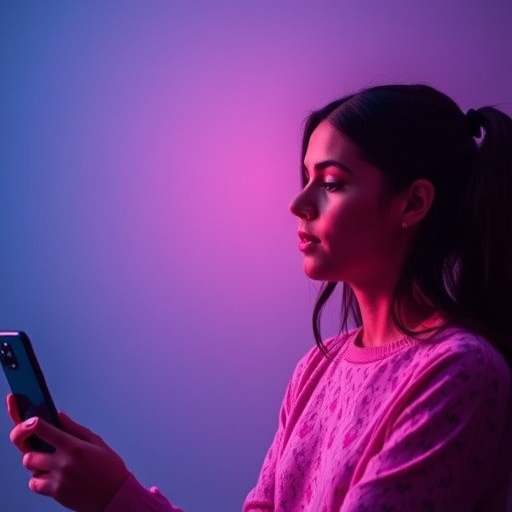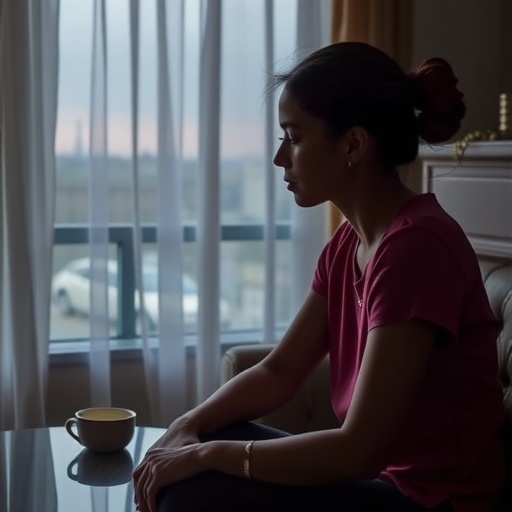
In the relentless swirl of today’s digital frenzy, TikTok has cemented itself not only as a powerhouse of social media entertainment but also as a complex terrain influencing users’ psychological landscapes. Recent research by Yao, Chen, and Elhai, published in the 2025 edition of the International Journal of Mental Health and Addiction, dives deep into the intricate interplay between emotional regulation difficulties and problematic TikTok use. Employing a sophisticated cross-lagged panel network analysis, the study brings novel insights into the bidirectional relationship between how users manage emotions and their compulsive engagement with this increasingly ubiquitous app.
At the heart of this study lies a pressing question: does struggling to regulate one’s emotions predispose individuals to problematic TikTok behavior, or does excessive and addictive use of TikTok exacerbate emotional dysregulation? Prior studies in social media research have often treated these constructs separately, falling short of unpacking their temporal and dynamic interrelations. The utilization of a cross-lagged panel network model allows the researchers to uncover the directional influence of these variables over time, moving beyond simple correlation and edging closer to the elusive mechanisms underpinning this relationship.
TikTok’s format—characterized by ultra-short videos, algorithmically curated content streams, and a potent feedback loop of instant gratification—creates an environment ripe for addictive behaviors. For many users, TikTok is more than a time-filler; it becomes a refuge from negative emotional states and anxiety-provoking circumstances. The central hypothesis tested in the study posits that individuals who experience notable difficulties with emotional regulation, such as trouble recognizing, accepting, or modulating emotions, may turn to TikTok compulsively in an attempt to self-soothe or escape from emotional turmoil.
.adsslot_rBTv7VDSKs{width:728px !important;height:90px !important;}
@media(max-width:1199px){ .adsslot_rBTv7VDSKs{width:468px !important;height:60px !important;}
}
@media(max-width:767px){ .adsslot_rBTv7VDSKs{width:320px !important;height:50px !important;}
}
ADVERTISEMENT
Yao and colleagues drew upon a longitudinal sample to measure indicators of emotion regulation difficulties and problematic TikTok use at multiple time points. The cross-lagged approach used in their analysis permitted them to parse out which construct exerts a stronger temporal influence over the other, while also considering the complex network of interactions among specific symptom clusters and behaviors. The visualized network analysis in the article captures these dynamic interactions, illustrating the bidirectional but asymmetrical relationships governing this digital-psychological feedback loop.
Their findings indicate a nuanced and mutually reinforcing cycle: heightened problems with emotion regulation at an earlier time point predicted increased problematic use of TikTok later on, while excessive TikTok use subsequently worsened emotional regulation difficulties. Notably, the effect of emotional regulation difficulties on problematic TikTok use appeared to be somewhat stronger than the reverse influence. This insight is vital for mental health professionals aiming to design targeted interventions, suggesting that bolstering emotional coping skills might serve as a preventative barrier against addictive engagement with TikTok.
Crucially, the network analysis further revealed that certain emotion regulation deficits—such as impulse control problems and limited access to emotion regulation strategies—were more central nodes driving problematic TikTok use. In other words, users who struggle to control impulsive reactions to distress or fail to deploy healthy coping mechanisms are most vulnerable to falling into harmful patterns of TikTok consumption. Conversely, TikTok’s addictive mechanics—such as algorithmic reward timing and social validation through likes and shares—can intensify emotional dysregulation, creating a perpetuating vicious cycle.
This research sheds light on the subtle yet powerful ways digital exosystems interface with human psychological functions. Viewing TikTok use solely as a behavioral addiction neglects the emotional substrates shaping it. Yao and colleagues argue convincingly that a better understanding of the underlying emotional disruptions is essential for mitigating the escalating mental health consequences tethered to problematic social media engagement. With TikTok’s user base expanding globally and its algorithms evolving with increasing sophistication, these findings are set to stir significant discussions in both clinical and technological domains.
Their analysis also beckons us to rethink the responsibility of platform designers. If emotion regulation difficulties exacerbate addictive use, then app interfaces optimized for engagement need to incorporate protective measures that empower emotional awareness and regulation. Features such as usage time warnings, mood-check reminders, or even embedded psychological self-assessment tools could serve to disrupt the spiraling cycle highlighted by the data. In this light, mental wellness becomes not just a user concern but an ethical design mandate.
Moreover, the study’s methodological approach exemplifies the growing trend of marrying advanced statistical techniques with psychological theory to decode digital behavior. Cross-lagged panel network analysis, by integrating temporal ordering with symptom-level associations, provides a granular lens that reveals the cascading influences unfolding over time. This opens doors to future studies examining other social media platforms or diverse emotional challenges and how they intersect with varying patterns of digital consumption.
While the study focuses on TikTok, its implications resonate broadly across the social media ecosystem. Platforms that similarly exploit rapid content delivery and tailored feeds likely elicit comparable emotional dysregulation loops in vulnerable populations. These results also deepen conversations about adolescent mental health, given that younger users are especially prone to emotion regulation struggles and heavy social media use. Identifying early markers and intervention points become crucial in curbing potential long-term psychological harm.
Yet, the researchers caution against oversimplification. Not all TikTok use is deleterious, and many users derive legitimate social connection and joy from the platform. The complexity lies in distinguishing healthy engagement from problematic use rooted in emotional coping deficits. Future empirical work inspired by this study could focus on elucidating protective factors and resilience mechanisms, creating a more complete ecosystem model of user wellbeing.
In the unfolding saga of digital mental health, this investigation into emotion regulation and TikTok addiction threads a key piece of the puzzle. It underscores that the mind’s emotional capacities play a pivotal role in how technology imprints on our lives, and vice versa. As society reckons with the mental health consequences of immersive social media, insights like these are indispensable for crafting nuanced solutions that honor the deeply human side of technological experience.
Yao, Chen, and Elhai’s study marks a turning point in the scientific discourse about social media addiction, offering evidence-based pathways to intervention grounded in psychological science. Their work challenges researchers, clinicians, and developers alike to acknowledge the emotional undercurrents fueling digital addiction and to innovate approaches that foster sustainable and healthy interaction with ever-more powerful technological platforms. The future of mental health in a digital age depends on integrating this knowledge into tangible, user-centric strategies.
In conclusion, the bidirectional, time-sensitive relationship between emotional regulation difficulties and problematic TikTok use revealed through cross-lagged network analysis paints a sophisticated portrait of contemporary psychological and digital interaction. It beckons a collaborative and interdisciplinary response—melding psychology, data science, and ethical technology design—to mitigate risks while harnessing social media’s positive potentials. As TikTok continues to captivate global audiences, studies like this shine new light on the unseen psychological webs spun beneath the viral clips and endless scrolls.
Subject of Research: The dynamic relationship between emotion regulation difficulties and problematic TikTok use, examined through cross-lagged panel network analysis.
Article Title: A Cross-lagged Panel Network Analysis of the Relationship Between Emotion Regulation Difficulties and Problematic TikTok Use.
Article References:
Yao, N., Chen, J. & Elhai, J.D. A Cross-lagged Panel Network Analysis of the Relationship Between Emotion Regulation Difficulties and Problematic TikTok Use. Int J Ment Health Addiction (2025). https://doi.org/10.1007/s11469-025-01502-5
Image Credits: AI Generated
Tags: bidirectional relationship social mediacompulsive engagement with appscross-lagged panel network analysisdigital mental health challengesemotion regulation difficultiesemotional dysregulation and addictionemotional management in digital ageinstant gratification feedback loopsproblematic TikTok usepsychological impacts of TikToksocial media addiction researchuser psychological landscapes





